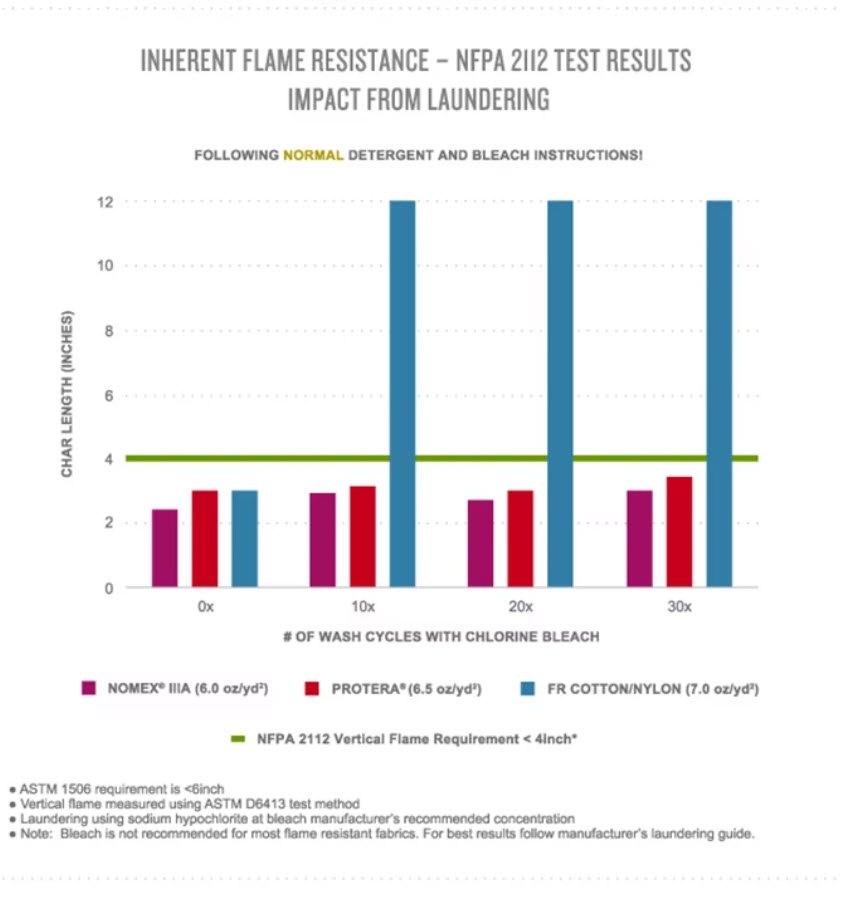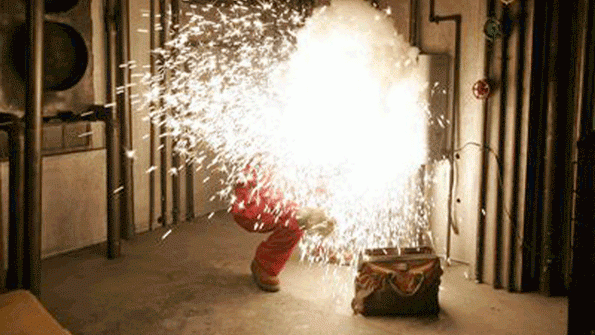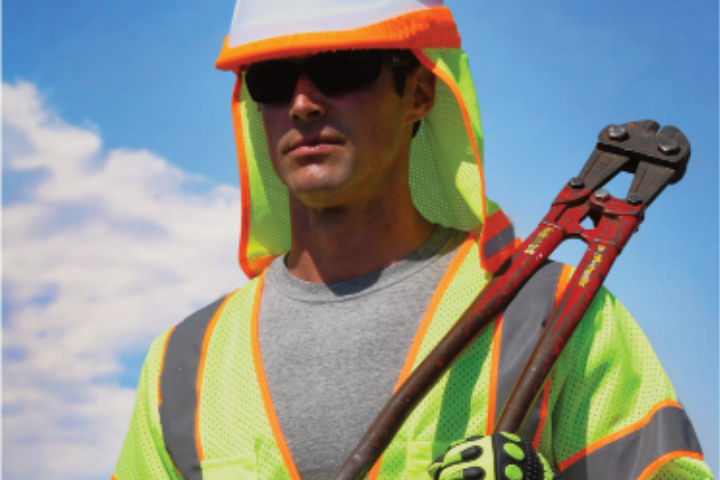“Inherent” and “treated” are words you’ll hear used when referring to flame-resistant (FR) material. However, not many people actually understand exactly what those terms mean when it comes to personal protective equipment (PPE).
But it’s crucial information when you’re the one in charge of buying reliable PPE for your crew. So what does each term stand for when it comes to PPE products?
Before we dive into the differences, let’s first look at the similarities. Knowing how FR clothing (inherent or treated) is defined in general will help us understand the specifics of each.
What Fabrics are Considered FR?
Although all fabrics will burn, some are naturally more resistant to fire than others. Flame-resistant (FR) fabrics are made to be difficult to ignite and will burn much slower if on fire than other fabrics.
Most importantly, FR fabrics will self-extinguish after removing the heat source.
According to the Occupational Safety and Health Administration (OSHA), even clothing made from 100% cotton or wool may be an acceptable FR garment if adequately treated and its weight is appropriate for the conditions to which a worker could be exposed to fire hazards.
The amount of heat required to ignite FR materials depends upon a number of factors, including the material’s weight, texture, and weave.
Inherent vs. Treated FR Garments
There is a wide range of FR garments available, both inherent and treated. So, choosing the best one for your job requirements can be difficult. Knowing what each offer will help you make an informed decision.
Inherent FR Fabrics
The actual value of inherent FR fabrics, according to DuPont™, a major player in FR products, is that garments made from them keep their flame resistance for life. It’s FR protection that never washes out.
Inherent FR fabrics are made of fibers with naturally built-in FR properties that can never be worn away or laundered out. The actual structure of the fiber is non-flammable; therefore, the flame-resistant trait is permanent.
Inherent FR fabrics will also have a higher Thermal Protective Performance (TPP) score than treated FR fabrics.
According to Industrial Safety & Hygiene News (ISHN), a garment’s TPP score is two times the number of seconds it takes for a second-degree burn to occur when exposed to a 2.0 cal/cm2 flame and radiant heat source. The higher the TPP rating, the higher the level of protection provided by the garment.
It’s important to note, though, that damage to the garment through even just regular wear and tear can diminish the FR properties.
Treated FR Fabrics
The term “treated” when it comes to FR for PPE garments means a fabric has flame-resistant properties, which are only applied to the material’s surface. It still offers a layer of FR protection but will eventually wash out.
Treated FR fabrics are constructed by applying a flame-retardant chemical finish or by including chemical treatments to the fibers before they are woven or knitted into the fabric.
The chemicals form a strong bond with the long strings of small organic molecules that make up the fabric. The FR chemicals will last longer if the recommended laundering instructions are followed accurately.
Treated FR fabric has a lower TPP rating, and the FR protection will, over time, diminish. It is a much more affordable option when the level of FR protection required is appropriate.
Can FR Properties Be Removed From a Garment?
For treated FR fabric, such as FR cotton/nylon blends, the most common way wearers will lose flame-resistant properties from their garments is by using regular chlorine bleach when washing them.
And unfortunately, the worker wearing it would not be able to tell that it no longer has flame resistance by merely looking at the PPE garment. Therefore, the use of chlorine bleach is never recommended.

The flame-resistant properties cannot be removed with inherent fabrics, even with bleach. But the garment can be damaged if improperly washed, which will make it less FR protective.
What Standards Cover Use of FR Clothing?
Generally, FR clothing is defined as clothing made from fabrics that self-extinguish once the ignition source is removed. However, the specific definition varies among industries.
From OSHA’s far-reaching General Duty Clause to specific FR clothing-related standards as laid out by ASTM International, employers must understand and comply to protect their employees from thermal injury when the work environment presents a threat. This includes hazards like exposure to an open flame and radiant heat.
The General Duty Clause is just that – very general. It was created as a base standard for all employees and requires employers to:
“…furnish to each of his employees employment and a place of employment which are free from recognized hazards that are causing or are likely to cause death or serious physical harm to his employees.”
OSHA’s 1910.132 ruling is again quite general and addresses workers’ PPE costs:
“Except as provided by paragraphs (h)(2) through (h)(6) of this section, the protective equipment, including personal protective equipment (PPE), used to comply with this part, shall be provided by the employer at no cost to employees.”
However, OSHA gets more specific in its 29 CFR1910.269 rulings, which state:
“The employer shall ensure that each employee who is exposed to the hazards of flames or electric arcs does not wear clothing that, when exposed to flames or electric arcs, could increase the extent of injury that would be sustained by the employee. This apparel standard applies to all apparel worn by an employee exposed to the hazards of flames or electric arcs.”
Understanding the “269” Standard for FR Garments
Because an electric arc flash is one of the most serious burn hazards to watch out for, OSHA addresses it specifically with the “269” standard.

The “269” standard (1910.269(l)(8)) prohibits workers from wearing clothing that, in the presence of an arc, can potentially increase the extent of injury; that is, if the clothing ignites and continues to burn or if it melts on the skin.
The “269” standard provides guidance for complying with the apparel requirements and gives information on the acceptable types of clothing permitted.
Clothing does not adhere to the standard if it ignites (and continues to burn) under an electric arc or flame exposure conditions common in some workplaces.
ASTM International uses its D6413/D6413M-15 test method to ensure compliance with the OSHA rulings as applied to FR products. It is a vertical flame test and one of the most commonly used tests on FR fabrics.
Which FR Material Fits Your PPE Needs Best?
Outside of OSHA rulings and ASTM standards, there are a few additional considerations to keep in mind when selecting which FR garment is best for your needs.
Before choosing what type of FR equipment to purchase, look at the work requirements and how the clothing should perform to live up to them. Does your FR garment need to offer other safeguards like weather protection, hi-visibility, or static resistance, to name a few?
Other factors, including comfort, color, and overall appearance, are also important, as are costs. Ultimately, you want to select an FR garment that keeps your team safe without the additional expense of protections not required in your environment.
Liberty Safety offers treated FR products like raincoats and vests at competitive prices in a variety of styles to choose from. You can get more information on those products along with our entire collection of PPE by downloading your free copy of the Liberty Safety Complete Product Catalog.


